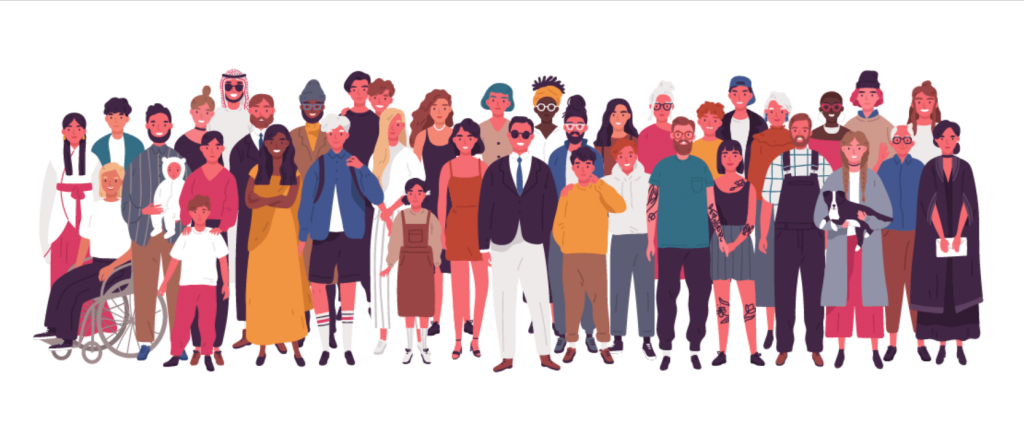‘We need more images of middle-aged white men please’. I’m not joking. This exact phrase was said during my first ever call with a client in the learning technologies industry. Luckily, I was only there to observe, so they were spared my stutters of disbelief.
Don’t get me wrong, I understood where they were coming from. The majority of the audience for this particular course was management. And in their company, that meant middle-aged white men. They wanted their audience to relate to the characters in the course to promote engagement, and so we changed the photographs.
This happened a few years ago, and I still think about it every day. My (maybe naïve) viewpoint, is that instead of changing these photographs, why don’t you change your hiring practices? Why don’t you work to make sure your employee base reflects the diversity of the world so that your courses can too?
Why do we need to diversify our courses?
In the past few years, we have seen a major shift in public perception towards equal representation, which is, thankfully, being reflected in the majority of goods and services we consume. The world of advertising, for example, is making a conscious effort to portray the world as it actually is, in all its glorious colours, shapes and sizes. Granted that some of this is being met with hostility from keyboard warriors in comment sections, but studies have shown that creating diverse adverts leads to increased sales, and really, who cares what keyboard warriors have to say.
We don’t live in the 1950s anymore. The workforce is more diverse than ever, and this should be reflected in how we learn. The traditional way of thinking about characters or images is that when learners ‘see’ themselves in a course, engagement goes up. They place more value on information that comes from someone that looks like them and so elearning should be more diverse.
Like most things in life, it’s not that simple. What if, like my client, your employee base is mainly one gender and race? Personally, I don’t think this is much of an argument against diversity in elearning courses.

Being in a diverse environment brings different points of view, enhances creativity (which leads to innovation), and can even make us smarter. This article from Scientific American pulls together decades of research from all sectors, to help show that having a mix of races, genders, ethnicities, and sexual orientations in a group makes for better problem solving and decision making. Not just because people with different backgrounds bring new information, but because being exposed to diversity can actually change the way you think.
If innovation is valued by your company, then having a diverse workforce will help push your workforce to think differently, and challenge existing work patterns. An example of this is a study undertaken in 2004 by Anthony Lising Antonio. They found when a black student presented a dissenting opinion to a group of white students, it led to broader thinking than when a white student introduced the same opinion. And it isn’t just race, studies around this topic with gender, sexual orientation and other characteristics have produced similar results.
In the past learning theory has placed a lot of emphasis on learners relating more to people that look like them, but is this what we actually want? Don’t we want to challenge our employees and get them thinking differently? Adding diversity to a group (or indeed an elearning course) means people will anticipate a difference of perspective. They become more open-minded and so learn more. Why shouldn’t this apply to who your learners see in an online course?

Added to this, is the fact that Millennials and Gen-Zers are coming into the workforce and demanding social responsibility from the companies they work for. These employees are much more likely to show loyalty if companies show their social value. Diversity in online learning is one small but simple way to show your commitment to this. Of course, ensuring you have a diverse workforce is the best way to show your commitment to diversity.
Why is it a challenge?
As an industry, we’re historically not great at diversifying our content, and we’re getting later and later to the party. Over the last ten years characters and images in elearning courses have started to change, but this is mainly in terms of gender and colour. Think about it, when was the last time you saw a disabled character in a course?
One of the major issues for elearning developers is a lack of diverse stock photography, especially if you want a character to be depicted throughout a learning journey. There’s not much we can do about that, except holding our own photoshoots, which can be expensive. Some suppliers though, (including Getty) have already pledged to diversify their images in the wake of the BLM movement last year.
Where do we go from here?
Well, clearly this is a complex issue.
Character led narrative courses are more popular and effective, so it’s time to put more effort and thought into developing the characters within them. Give them back stories and really think about their lives. At the very least we should be aiming for more cultural and gender diversity.
Overall, we need to really think more about the images and characters we put into courses, and how they can challenge your learners. We shouldn’t always put the middle-aged white man as a manager, or the young woman as an intern. It’s lazy and we’re just feeding stereotypes. Using characters that are fully developed and diverse can be a way of breaking down unconscious bias and emphasising that diversity is not just an exercise in tokenism. Perhaps it will even lead to innovation and a culture change in your company.
Get in touch to explore how we can support you in developing your learning strategy to drive innovation and performance within your workforce.





